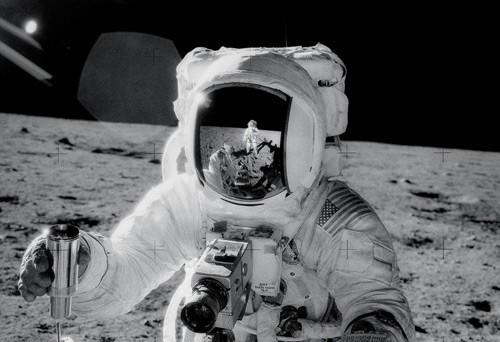
By Louise Mayor in San Francisco
Day two of AGU Fall 2015 saw the likes of SpaceX CEO Elon Musk and NSF director France Córdova talking in rooms packed full of earth and space scientists. But what grabbed my attention was a short talk by Nancy Todd of NASA’s Astromaterials Acquisition and Curation Office.
NASA being NASA, I assumed that all its data from completed missions would by now have been digitized and made accessible. That, I learned, is not true – but Todd and her colleagues are on the case.
So why isn’t this data digitization as straightforward as one might think? From 1969 to 1972, Apollo astronauts collected 2196 samples of rock, soil and drive-tube cores from the Moon, and what I hadn’t appreciated before Todd’s talk is the sheer volume of analogue data – such as photographs and handwritten notes – that this includes.
Each of the 2196 samples is documented in three stages. First, there are data surrounding the sample collection and transport. These include videos of astronauts collecting the sample, location photos showing before and after shots, maps showing where the sample was collected and photo panoramas showing where the sample came from. This kind of information helps scientists make correlations between samples that, for example, are collected near a giant rock or in a crater.
Second, what’s known as a “sample datapack” is created to describe every step of sample processing in the lab. It also includes photos intended to be scientifically useful, such as 360° views of the sample and stereoscopic photos.
Third, there is the sample analysis: there are more than 5000 published studies about lunar samples. But there is also a wealth of unpublished data that principal investigators haven’t got round to publishing. The Lunar Sample Compendium was created to bring this information together – to link the studies with the sample information – however, this is contained entirely as PDF files, which are difficult to search and use, not least because some the files include scanned handwritten documents.
So how is the Astromaterials Acquisition and Curation Office tackling the issue of managing these data and preserving them for the years to come? The team has already completed the Apollo Lunar Sample Photograph Digitization Project in which the original film negatives of Apollo’s lunar rock-sample photos were digitized.
Another effort is now under way to digitize the sample datapacks. The datapacks have so far all been scanned, resulting in what Todd described as more than 400 feet – more than the length of a soccer pitch – of files, if you were to print them all out. The next step, says Todd, will be to figure out how to index these data and tie them to the sample identification numbers. Another challenge will be to figure out how to collect and use handwritten data, so that they can be used for searches.
One final plan is to piggyback on an already existing data system called PetDB, the Petrological Database, which holds data for rocks found on Earth, and instead make a lunar version named MoonDB.
The Astromaterials Acquisition and Curation Office has been protecting and curating NASA’s extraterrestrial samples now for more than 45 years. Its challenge now is to preserve the Apollo legacy – as well as samples from meteorites, comets and asteroids – so that we can continue to develop our understanding of our closest celestial neighbour for the years to come.



